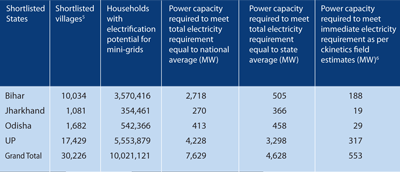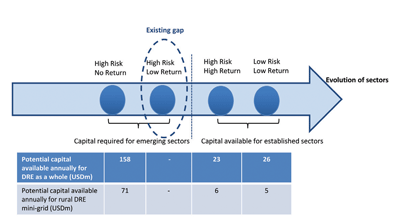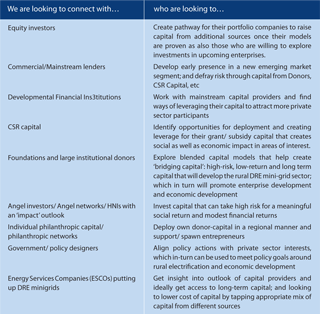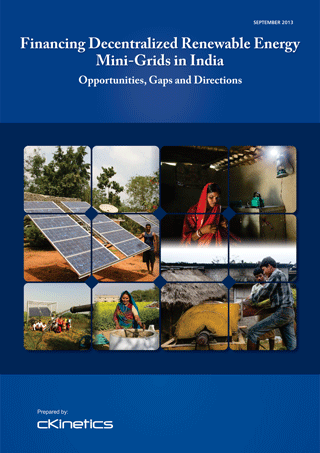Decentralized Renewable Energy (DRE) based rural
electrification is a rapidly emerging sector in
India. Investors are just beginning to understand
the business model, commercial viability, risks and
opportunities that this sector presents.This report
provides a perspective on opportunities, gaps and
directions for financing in this emerging sector. It
is not only meant to be a primer but also serve as a
resource guide.
Analysis of the top 4 states in India which are most
deficient in electricity supply (namely Bihar, Uttar
Pradesh, Odisha and Jharkhand) reveals that there
exists an immediate power requirement of atleast
553MW in around 30,000 villages which can be met
through rural DRE mini-grids. This demand goes up to
4,628 MW if we consider electricity needs equal to
the state average per capita consumption and to
7,629 MW if we consider the national average.

The capital requirement to meet this potential
demand is estimated to be ranging from USD 922
million to USD 12.7 billion depending on the
scenario chosen for potential electricity
consumption by rural households.
USD 82 million of capital is estimated to be
available for deployment in the rural DRE mini-grid
sector in India, of which USD 71 million is
grant/donor capital and only USD 11 million is
available from non-grant sources. Considering the
estimated demand for capital, it is evident that
currently there is a low level of interest from
private mainstream capital providers to invest in
this space.
Mismatch between accessible capital and what
is needed Assessment of the landscape of
capital supply and the demand for capital reveals
that there seems to exist a mismatch between the
type of funds that the rural mini-grid DRE projects
need and what is available from the various sources
of capital.
What is available is capital that is either meant
for established business models (low-risk and
low-return capital) or where the businesses provide
attractive returns with a potential for an upside
(high-risk and high-return).
In addition, grants and subsidies (high-risk and
no-return capital) are available to help test
business models in the rural mini-grid DRE space
however ‘bridging capital’ (high-risk and
low-return) required to support high-risk DRE
mini-grid ventures and enable them to create a track
record (that can then be supported by mainstream
capital) is missing.
This ‘bridging capital’ is what the rural mini-grid
DRE sector presently needs: i.e. capital with high
risk appetite, low return expectations (given the
risk) and a long tenure (given the nature of the
projects). Unfortunately not many capital providers
fall under this bucket.

|
Directions for financing DRE mini-grids and
going beyond this report
In an on-going exercise through 2013 and
2014, cKinetics is leading an effort to identify
pathways to bridge the apparent mismatch and gap
between the supply of capital and the (known) demand
of capital for rural DRE mini-grids.
The desired outcome is that the proposed financing
interventions would not only attract investors and
donors to the rural mini-grid DRE space but also
help project developers achieve target IRRs and make
them investment-worthy of the different types of
capital that maybe accessible.
Some of the potential interventions/facilities being
ideated upon include: Co-developer equity facility*;
Long term, low cost loan facility and Asset owner
facility that owns the mini-grid amongst others. Due
to the requirement of low cost funds, different
models of blended capital structures that are
supported by CSR or other donorsare being evaluated.

This space continues to see active developments. In
order to engage with some of the follow-up
activities listed above, please send an email to:
contact@cKinetics.com
+91.11.4050.7277
|



